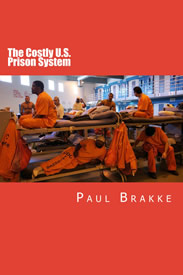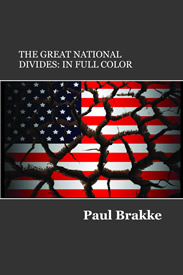FOR IMMEDIATE RELEASE
The Amber Guyger verdict has been like a Rorschach test according to criminal justice expert, Paul Brakke, publisher of American Leadership Books and author of nine books on the criminal justice system and American society. According to Brakke, the case can be viewed in this way, because the different sides have let their attitudes frame their interpretation of the facts of the case, the verdict, the sentence, and the actions of the judge and victim’s brother after the verdict.

Even the basic facts of the case and the process of charging Amber first for manslaughter, and later for murder are disputed, as Brakke describes. The events started back in September 6, 2018, when Amber Guyger returned to her 3rd floor apartment in Dallas at about 10 p.m. after work. But she mistakenly went to the 4th floor apartment of Botham Jean, pushed open the door which she claimed was unlocked, and thought the dark shadowy figure inside was a burglar. She thought he might have been coming towards her to attack her, so she fired, though Jean was actually eating a bowl of ice cream
Afterwards, she felt agonized remorse because she truly believed she was threatened by the burglar and felt guilty at what she had done when the truth came out — that she had shot a black man in his own apartment while thinking he was in her apartment.
Unfortunately, the politics of race in America turned this case into a morality play about racial injustice in America, as protesters used the tragedy as a canvas in which to demonize Amber and the police. Brakke is not trying to justify what Amber did or to ignore the alternatives to shooting which she might have had, such as backing away from the apartment and calling the police or shooting at the burglar’s legs, rather than shooting to kill.
But as Brakke explains: “What does seem wrong is the way protesters have used legitimate complaints about the criminal justice system to urge a harsh verdict for Guyger and act in an unseemly manner.”
How? As Brakke notes:
“The protesters raised suspicions about the way the Dallas police handled the case from the outset. They suggested that the police were treating Amber more leniently than they would if the racial dynamics had been reversed so that a black cop had shot a white civilian.”
For example, the protesters thought it was wrong that it took a full 72 hours for the police to finally arrest Guyger and charge her with manslaughter, when that can be a usual time for investigating and processing a case.
The protesters also claimed it was unjust that Amber was only held for a few hours in custody before she was released on a bond of $300,000. They questioned why the five search warrants for Guyger’s home weren’t executed and why it took 18 days for her to be fired by the Dallas Police. In their view, this was evidence that the police were treating Guyger with kid gloves, because they didn’t value the lost life of Botham Jean because he was black.
Brakke points out that the protesters soon took over the narrative and turned the killing into an even bigger national story, when they interrupted and shut down the Dallas City Council meeting on September 12 by chanting “No justice, no peace.”
Then, Botham’s family contributed to further politicizing the case when they sued the city of Dallas on September 26, claiming that Botham’s civil rights were violated when off-duty Dallas Police Officer Amber Guyger mistakenly went into his apartment and shot and killed him.
In Brakke’s view this politicization of the case led to the charge of manslaughter being turned into a murder charge, when the Dallas grand jury upped the manslaughter charge to murder on November 18, 2018. Then, when Guyger’s trial finally began on September 23rd, 2019, Brakke was not surprised at the guilty verdict, noting that “It would seem that given the political climate, a guilty verdict was guaranteed. The black judge didn’t allow the jury to hear the testimony of a Texas Ranger who thought Amber Guyger’s response was reasonable. Even though Amber broke down in tears over the tragic events, the jury quickly came back with a guilty verdict after 24 hours, and the protesters cheered at this result.”
Still, Brakke felt there was at least some measure of fairness when the jury decided on a 10 year sentence, which seemed like a middle ground, since they could choose between five to 99 years or life in prison, while the prosecutor was seeking a 28 year sentence. That wasn’t sufficient for the protesters, who felt the verdict was unfairly light, arguing “no justice, no peace” in the hallway, and then they demonstrated in the streets of Dallas over the sentence.
Yet, Botham’s 18 year old brother, Brand Jean, told Amber “I forgive you,” and embraced her for 40 seconds. Some jurors had broken out in tears before rendering the sentencing verdict. Even the judge, State District Judge Tammy Kemp, showed a spirit of mercy and forgiveness, when she went over to Amber after the verdict, cried, and handed Amber a Bible, advising her how she might read it, notably John 3:16, to find some solace.
Thus, as Brakke concluded, the case really occurred due to a horrible tragedy in which there were no winners, only losers. Even though Amber felt true remorse and horrible for what she did, the protesters sought to frame this case as an example of racial injustice. To them, Amber represented the system that unfairly targeted blacks, not an individual who made a horrible mistake.
At least, given the political pressures they were under, the diverse jurors (2 whites, 5 blacks, and 5 Hispanics and Asians), found a reasonable middle ground, according to Brakke. He feels that despite a protest movement seeking blood for racial justice, the jurors managed to find a middle ground between total exoneration, which would have provided even more fuel to the protesters claim of injustice, and bending to their demand for the highest penalty possible, even life in prison. This is far better than an all-white or all-black jury might have found.
As Brakke put it:
“The way I see it, there were no winners and only losers in this horrible tragedy, which became a kind of litmus test for attitudes about racial justice.
But the jurors managed to find a balance between the two opposing sides in this criminal justice mess. They came up with a reasonable verdict, and it was especially good that a diverse jury decided the case.’
What Brakke and many others found most remarkable were the actions of Botham’s brother in hugging and forgiving Amber, and those of Judge Tammy Kemp in giving her a Bible, actions never before reported in a courtroom, at least publicly.
Both actions speak toward black feelings of redemption and represent humanity’s better nature. Brakke finds it understandable but regrettable that many blacks have criticized these gestures because whites have never responded in a similar fashion to blacks who have erred.
As Brakke states:
“I would much sooner hope that such actions on the part of Botham’s brother and the judge would serve as model behavior for how we should all act toward each other if we ever wish to overcome our racial divide.”
Contact:
Jana Collins
Jones & O’Malley
jana@jonesomalley.com
Toluca Lake, California
(818) 762-8353




